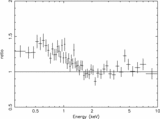Revealing a Cool Accretion Disk in the Ultraluminous X-Ray Source M81 X-9 (Holmberg IX X-1): Evidence for an Intermediate-Mass Black Hole
Abstract
We report the results of an analysis of two XMM-Newton EPIC-pn spectra of the bright ultraluminous X-ray source M81 X-9 (Holmberg IX X-1) obtained in snapshot observations. Soft thermal emission is clearly revealed in spectra dominated by hard power-law components. Depending on the model used, M81 X-9 was observed at a luminosity of LX=(1.0-1.6)×1040ergss-1 (0.3-10.0 keV). The variability previously observed in this source signals that it is an accreting source that likely harbors a black hole. Remarkably, accretion disk models for the soft thermal emission yield very low inner disk temperatures (kT=0.17-0.29 keV, including 90% confidence errors and variations between observations and disk models) and improve the fit statistic over any single-component continuum model at the 6 σ level of confidence. This represents much stronger evidence for a cool disk than prior evidence that combined spectra from different observatories, and the strongest evidence of a cool disk in an ultraluminous X-ray source apart from that for NGC 1313 X-1. In common with NGC 1313 X-1, scaling the temperatures measured in M81 X-9 to those commonly seen in stellar-mass Galactic black holes at their highest observed fluxes (kT~=1 keV) may imply that M81 X-9 harbors a black hole with a mass on the order of 103 Msolar the measured disk component normalization and broadband luminosity imply black hole masses on the order of 102 Msolar. It is therefore possible that these sources harbor 103 Msolar black holes accreting at LX~=0.1×LEdd. While these results do not represent proof that M81 X-9 harbors an intermediate-mass black hole, radio and optical observations suggest that beaming and anisotropic emission from a stellar-mass black hole are unlikely to account for the implied luminosity. We further argue that the strength of the hard emission in these sources and well-established phenomena frequently observed in stellar-mass black holes near to the Eddington limit suggest that optically thick photospheres are unlikely to be the origin of the cool thermal emission in bright ultraluminous X-ray sources. For comparison to M81 X-9, we have also analyzed the previously unpublished EPIC-pn spectrum of NGC 1313 X-1 cool disk emission is again observed, and refined spectral fit parameters and mass estimates are reported.
- Publication:
-
The Astrophysical Journal
- Pub Date:
- June 2004
- DOI:
- 10.1086/383563
- arXiv:
- arXiv:astro-ph/0310617
- Bibcode:
- 2004ApJ...607..931M
- Keywords:
-
- Accretion;
- Accretion Disks;
- Black Hole Physics;
- Relativity;
- X-Rays: Binaries;
- Astrophysics
- E-Print:
- 8 pages, 6 figres, 3 in color, uses emulateapj.sty and apjfonts.sty, ApJ accepted
